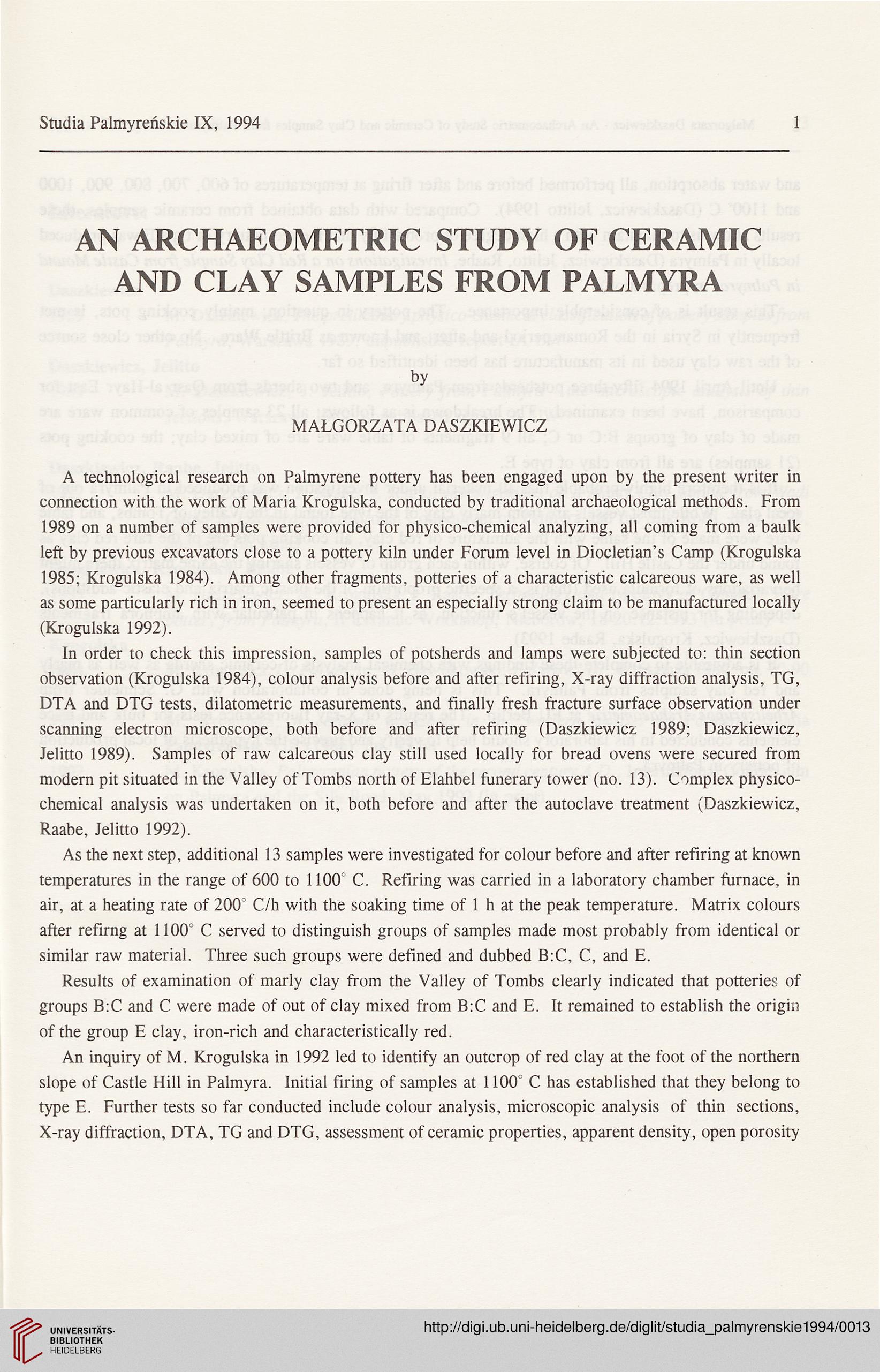Studia Palmyreńskie IX, 1994
1
AN ARCHAEOMETRIC STUDY OF CERAMIC
AND CLAY SAMPLES FROM PALMYRA
by
MAŁGORZATA DASZKIEWICZ
A technological research on Palmyrene pottery has been engaged upon by the present writer in
connection with the work of Maria Krogulska, conducted by traditional archaeological methods. From
1989 on a number of samples were provided for physico-chemical analyzing, all coming from a baulk
left by previous excavators close to a pottery kiln under Forum level in Diocletian’s Camp (Krogulska
1985; Krogulska 1984). Among other fragments, potteries of a characteristic calcareous ware, as well
as some particularly rich in iron, seemed to present an especially strong claim to be manufactured locally
(Krogulska 1992).
In order to check this impression, samples of potsherds and lamps were subjected to: thin section
observation (Krogulska 1984), colour analysis before and after refiring, X-ray diffraction analysis, TG,
DTA and DTG tests, dilatometric measurements, and finally fresh fracture surface observation under
scanning electron microscope, both before and after refiring (Daszkiewicz 1989; Daszkiewicz,
Jelitto 1989). Samples of raw calcareous clay still used locally for bread ovens were secured ffom
modern pit situated in the Valley of Tombs north of Elahbel funerary tower (no. 13). Complex physico-
chemical analysis was undertaken on it, both before and after the autoclave treatment (Daszkiewicz,
Raabe, Jelitto 1992).
As the next step, additional 13 samples were investigated for colour before and after refiring at known
temperatures in the range of 600 to 1100° C. Refiring was carried in a laboratory chamber furnace, in
air, at a heating rate of 200 e C/h with the soaking time of 1 h at the peak temperature. Matrix colours
after refirng at 1100° C served to distinguish groups of samples made most probably from identical or
similar raw material. Three such groups were defined and dubbed B:C, C, and E.
Results of examination of marly clay from the Valley of Tombs clearly indicated that potteries of
groups B:C and C were made of out of clay mixed from B:C and E. It remained to establish the origin
of the group E clay, iron-rich and characteristically red.
An inquiry of M. Krogulska in 1992 led to identify an outcrop of red clay at the foot of the northern
slope of Castle Hill in Palmyra. Initial firing of samples at 1100° C has established that they belong to
type E. Further tests so far conducted include colour analysis, microscopic analysis of thin sections,
X-ray diffraction, DTA, TG and DTG, assessment of ceramic properties, apparent density, open porosity
1
AN ARCHAEOMETRIC STUDY OF CERAMIC
AND CLAY SAMPLES FROM PALMYRA
by
MAŁGORZATA DASZKIEWICZ
A technological research on Palmyrene pottery has been engaged upon by the present writer in
connection with the work of Maria Krogulska, conducted by traditional archaeological methods. From
1989 on a number of samples were provided for physico-chemical analyzing, all coming from a baulk
left by previous excavators close to a pottery kiln under Forum level in Diocletian’s Camp (Krogulska
1985; Krogulska 1984). Among other fragments, potteries of a characteristic calcareous ware, as well
as some particularly rich in iron, seemed to present an especially strong claim to be manufactured locally
(Krogulska 1992).
In order to check this impression, samples of potsherds and lamps were subjected to: thin section
observation (Krogulska 1984), colour analysis before and after refiring, X-ray diffraction analysis, TG,
DTA and DTG tests, dilatometric measurements, and finally fresh fracture surface observation under
scanning electron microscope, both before and after refiring (Daszkiewicz 1989; Daszkiewicz,
Jelitto 1989). Samples of raw calcareous clay still used locally for bread ovens were secured ffom
modern pit situated in the Valley of Tombs north of Elahbel funerary tower (no. 13). Complex physico-
chemical analysis was undertaken on it, both before and after the autoclave treatment (Daszkiewicz,
Raabe, Jelitto 1992).
As the next step, additional 13 samples were investigated for colour before and after refiring at known
temperatures in the range of 600 to 1100° C. Refiring was carried in a laboratory chamber furnace, in
air, at a heating rate of 200 e C/h with the soaking time of 1 h at the peak temperature. Matrix colours
after refirng at 1100° C served to distinguish groups of samples made most probably from identical or
similar raw material. Three such groups were defined and dubbed B:C, C, and E.
Results of examination of marly clay from the Valley of Tombs clearly indicated that potteries of
groups B:C and C were made of out of clay mixed from B:C and E. It remained to establish the origin
of the group E clay, iron-rich and characteristically red.
An inquiry of M. Krogulska in 1992 led to identify an outcrop of red clay at the foot of the northern
slope of Castle Hill in Palmyra. Initial firing of samples at 1100° C has established that they belong to
type E. Further tests so far conducted include colour analysis, microscopic analysis of thin sections,
X-ray diffraction, DTA, TG and DTG, assessment of ceramic properties, apparent density, open porosity




